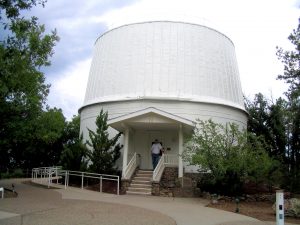Pluto
Pluto is a tiny world near the edge of our Solar System.
Our world was excited at its discovery and it spent over 70 years in the planetary family.
But time diminished Pluto.
It was resized and reclassified and is now just one of many dwarf planets.
Then it came back to prominence with the visit of a robot spacecraft.
Finding Pluto
Pluto was discovered in 1930 but the search began years before.
Finding Pluto was a difficult task, it was so far away.
In 1894, rich businessman Percival Lowell founded an observatory near Flagstaff, Arizona.

Blog author Dennis Ashton at Lowell Observatory, Az.
Photo: Dennis Ashton
Lowell became fascinated with the idea of an another planet beyond Neptune which became known as ‘Planet X’.
Lowell devoted his observatory to finding this new world. Sadly, he died in 1916 without finding it.
The search was resumed in 1929 and the task of finding Planet X was given to a young observer.
Clyde Tombaugh was just 23 years old when he joined Lowell Observatory.
He began a planned photographic search for the new planet.
After just one year, on February 18th, 1930, he found Planet X.

Dennis looking through a telescope at Lowell observatory.
Photo: Dennis Ashton
Tombaugh used a blink comparator, an instrument that let him compare two photos of the same area of sky.
He looked for any ‘star’ which had changed position.
On February 18th, 1930, he found one. It was ‘Planet X’.


Clyde Tombaugh and the blink comparator Dennis at the blink comparator

Discovery frames, Pluto marked with an arrow
Photo: Lowell Observatory
Naming Planet X
The next search was for a suitable name for the new world.
Astronomers made several suggestions but none gained universal favour.
Then an 11-year old girl in Cambridge, England came up with the ideal solution.
Venetia Burney suggested the name to her grandfather who passed it on to friends and eventually to Lowell Observatory.
Staff at the observatory voted unanimously for Venetia’s idea and she was awarded the grand sum of £5!
It was a perfect name not only because of it was the god of the underworld but it also began with the initials of Percival Lowell.
In May, 1930, Pluto was pronounced the the ninth planet in our Solar System..
The name was adopted by the Walt Disney studios when Pluto the dog joined Mickey Mouse.
Then in 1941 a newly made element was named plutonium.
Pluto Statistics
Average distance from Sun: 5.9 billion km
Nearest distance to Sun: 4.4 billion km
Farthest distance from Sun: 7.4 billion km
Diameter: 2,376 km
Orbital period (year): 248 years
Rotation period (day): 6 days, 9 hours
Temperature: minus 230 C
Pluto’s demotion
When Pluto was discovered, it was thought to be the size of the Earth.
But it’s size was revised downwards over the years.
It is smaller than our Moon and weighs in at only 0.2% the mass of earth.
In the 1990s, more objects were found orbiting in the same area as Pluto, the Kuiper Belt.
In 2006, the International Astronomy Union redefined a planet.
Regular planets should be spherical, orbit the Sun and have cleared their orbit of debris.
Pluto failed the last criterion and was demoted to a Dwarf Planet.
The IAU recognises several dwarf planets in the Kuiper Belt including Eris, Haumea, Sedna, Makemake , Quaoar and Varuna.
Pluto’s New Horizons
In July, 2015, Pluto was back in the news when the New Horizons space probe flew by the tiny world.
Launched in 2006, NASA’s probe took over 8 years to reach Pluto.
It flew by at 84,000 km/h (52,000 mph) just 12,500 km (7,800 mi) above the surface.
Even the most powerful telescopes on Earth show Pluto as a mere speck of light.
New Horizons images revealed Pluto for the first time.

Photo: NASA/JHUAPL/SwRI
New Horizons data shows that Pluto is an amazing little world.
The heart shaped region, was named Tombaugh Regio.
Its left side, named Sputnik Planita, is a nitrogen-ice glacier.
Venetia Burney, who died in 2016, is remembered by a nearby crater.

Photo: NASA/JHUAPL/SwRI
Close up images showed mountains made of solid water-ice and a hazy atmosphere.
There may be liquid water underneath the sea of ice.
Just as fascinating as the images of the dwarf planet were the close-ups of its largest moon, Charon.
They show a huge canyon, 1600 km long, stretching across the face of Charon.
The brown colouration at the pole maybe material blown from Pluto itself.

Pluto’s moon Charon
Photo: NASA/JHUAPL/SwRI
Pluto Trivia
Pluto’s eccentric orbit sometimes carries it inside the orbit of Neptune.
It spins the opposite way to most planets so the Sun rises in the west and sets in the east.
Pluto is smaller than several moons of other planets, including our Moon.
It has five moons: Charon, Hydra, Nix, Kerboros and Styx.
Clyde Tombaugh died in 1997. The New Horizons space craft carried his ashes to Pluto.
Officially, Pluto’s name is now asteroid number 134340.
Sunlight takes around 5 hours to reach Pluto.
The sky is so dark that anyone there would be able to see stars during the day.
Would you like to hear more Astronomy news?
Do you want to to find out about our upcoming public events?
Follow WonderDome Portable Planetarium on Twitter and Facebook or go to our web site wonderdome.co.uk!
The author: Dennis Ashton is a Fellow of the Royal Astronomical Society and a Wonderdome presenter.

